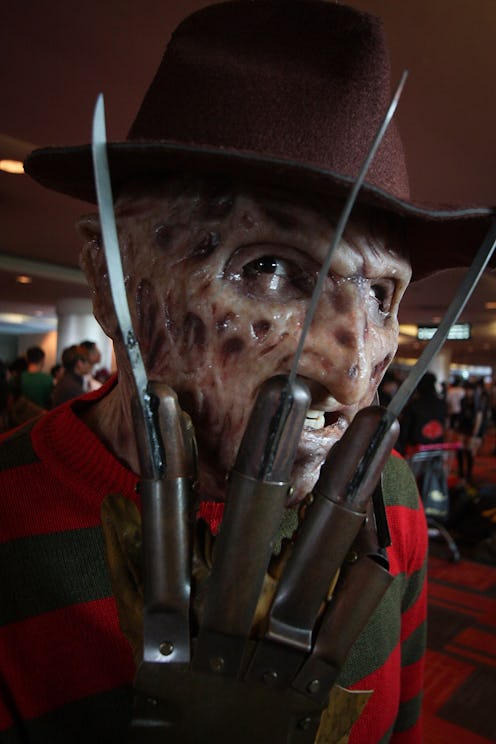If you’re a dangerous shut-in like myself, your 2014 Halloween plans involve not elaborate costumes and massive parties, but pumpkin ale and a night on the couch with all the best horror movies Netflix has to offer. Alas, A Nightmare on Elm Street isn’t one of them — but in case you’ve ever wondered whether nightmares can actually kill people, here’s your answer. Ready for some of the wackiest science you’ll ever see?
It’s true that most horror movie slashers are the literal representation of a lot of teens’ biggest fears; it’s the reason the monsters generally go after high school students, why anyone who has sex, drinks, or does drugs gets always gets offed, and more. Indeed, this sort of metaphor is the entire raison d’etre for Buffy the Vampire’s existence — it plays off of the idea that high school is hell. Literally. But earlier in October, Slate’s Rachel Stewart and Jeffrey Bloomer teamed up on a video exploring one of the real life inspirations for Freddy Krueger and the Nightmare on Elm Street series; it’s called SUNDS, and I would argue it’s even freakier than the idea of a dude with knives for fingers who stalks you when you’re at your most vulnerable.
Here’s the deal:
SUNDS: What Is It?
SUNDS stands for Sudden UNexplained Death Syndrome. According to Freddy creator and overall horror master Wes Craven, it’s one of the things that inspired the whole Nightmare on Elm Street franchise. It’s also pretty much exactly what it sounds like: A phenomenon in which people die without warning in their sleep.
When Did It First Appear?
In the years prior to Elm Street’s production, a report from the LA Times drew attention to SUNDS, describing it as a veritable plague in southeast Asia. One guy was apparently so freaked out about the phenomenon that he flat-out refused to sleep. This was how Craven discovered SUNDS… and after it landed on his radar, of course his creeptastic brain took it and riffed on it in the most terrifying way possible.
It’s worth noting, though, that the headline featured in the video may not actually be the article Craven meant — I dug it up, and it’s dated 1990. Since A Nightmare on Elm Street was released in 1984, it would have been impossible for the director to have read this particular article before beginning work on the movie (unless he has access to a time machine he hasn’t told us about). I did, however, also find an article on SUNDS from 1988 that stated the following:
“In 1981, the Centers for Disease Control began tracking a mysterious rash of sudden unexplained nocturnal deaths occurring in apparently healthy, male immigrants from Vietnam, Laos and Cambodia. The problem, unknown in other ethnic groups, has now claimed more than 104 men, averaging 33 years of age, and one woman, according to Dr. Gib Parrish, a CDC medical epidemiologist.
“Ninety-eight percent of the deaths occurred between 10 p.m. and 8 a.m.”
In light of this little tidbit, I’m guessing that Craven first heard about SUNDS around the time of the CDC's 1981 research.
How Does It Work?
Research revealed that there’s a reason SUNDS only seems to affect men from southeast Asia: It’s regionally and genetically related. Those who suffered from it — who, by the by, were otherwise perfectly health — would suddenly display some wacky heart activity in their sleep… and then just die. We don’t know much about the regional link at the moment, but we do a little about the genetic one: Some people seem to have abnormal genes that can cause electrical malfunctions in the heart. These malfunctions tend to occur at night, largely (we think) because that’s when the heart slows down, making the abnormality more pronounced.
Is it directly related to nightmares themselves? We don’t know yet. But young, healthy people do just die without warning in their sleep sometimes — and Freddy Krueger takes that idea and runs with it. Voila — consider yourselves enlightened.
Oh, and also:
Freddy Krueger Turned 30 This Year
Happy birthday, buddy!
Watch the full video below:
Images: Slate (4)
